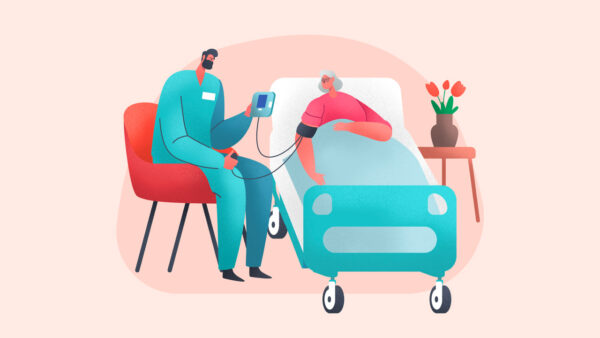
Person-centered care is about doing more than managing and treating disease. It engages with the whole person, not just physically but also emotionally, socially, and culturally. It acknowledges that the mind and the body can’t truly be separated, and that disease is best seen in a social context.
When done right, person-centered care can reduce health disparities, improve patient satisfaction, and support better self-management. According to a psychiatrist on Sermo, “Patient-centered and person-centered approaches to patients have been found to have significant positive associations with improved outcomes and decreased rates of mortality.”
In today’s world, this matters more than ever as patients’ expectations have risen, and health information is easily accessible. Patients demand for their individual preferences, circumstances and opinions to be acknowledged and considered when deciding their care plan.
Person-centered care is also important in developing patient trust. A patient who feels as if they are just another appointment and a list of symptoms in their physician’s day is never going to feel that they are being treated well and with respect, which may erode the doctor-patient relationship and affect health outcomes.
What is person-centered care? A definition
At the base level, person-centered care—also commonly known as patient-centered care—looks at the person first and then their symptoms. Traditional models of care can be one-size-fits-all and assume average courses of the disease, starting with “typical” treatments. It assumes that the patient is only a passive recipient of care.
By considering the person first, this reduces health disparities by taking into account socioeconomic differences, cultural preferences, as well as the different impacts of disease in different individuals such as on people of color, members of the LGBT community, or trans individuals. For example, patient-centered care might include referring a Jewish patient to a nutritionist who works specifically with people who keep kosher, or helping a low-income patient to find a suitable clinic nearby that offers financial assistance. It empowers patients by informing them and recognizing their, or their caregivers’, capabilities.
Principles of person-centered care
Many physicians wonder where to start when switching to a more patient-oriented system. Below are some principles physicians can use to guide their behavior and clinical decision-making to ensure personalized and empathetic care:
Respect for values
Patients bring their own unique values, beliefs and cultural backgrounds to the exam room that may not align with those of their physician. Practicing person-centered care means recognizing and respecting these values, rather than imposing one’s own perspective. This is especially important in areas that may involve moral, religious, or ethical sensitivity, such as reproductive health.
Connection and relationship-building
It is sometimes unavoidable to have multiple physicians work with a patient, especially in a hospital setting, but doctors should still strive to build a relationship with every patient.
When patients feel heard and understood, they’re more likely to engage actively in their healing process. Prioritizing the emotional as well as physical aspects of care reinforces trust and promotes whole-person wellness.
Holistic approach to physical, emotional, and social well-being
A holistic approach looks at emotional and social well-being as well as physical. It might include referring a patient to a counselor or social worker to help navigate personal challenges or process a difficult diagnosis, such as chronic or terminal illness.
It also means supporting complementary therapies like nutrition counseling or mindfulness practices such as meditation, while ensuring they are used alongside, not in place of, evidence-based medical treatment. A 12-month study at the University of Arizona clinic found that when participants received integrative primary care, they benefitted from broad improvements in physical, mental, and lifestyle outcomes such as improved sleep quality, improved work productivity, and notable enhancements in mental health scores.
Effective communication between physicians and patients
When physicians treat patients as people first, it allows for much more effective communication. This means patients get more accurate information and are more likely to comply with treatment. Patients are also more likely to be open with their physicians and fully explain their concerns with treatment options without fear of judgement.
An anesthesiologist on Sermo shares, “Good questioning, patient and attentive listening, more empathy and good treatment are the keys to a good doctor-patient relationship, generating trust and often improving results.”
Strong collaboration among healthcare providers
Another key aspect of patient-centered care is the development of strong, coordinated care teams. Healthcare providers from different disciplines and specialties must often work together to share expertise and information. Strong collaboration results in care plans that are more individualized and effective for each patient.
Continuous feedback and improvement
Above all, person-centered care means listening —to patients, their families, fellow physicians, and to the broader community. An internal medicine physician remarks, “In interacting with my patients I try to express and demonstrate a demeanor of compassion, listening ability and an attitude to show attentiveness that is sincere coming from the heart as well as provide quality time. This I believe will lead to optimum trust and improved diagnostic acumen and treatment.”
By inviting and reflecting on that feedback, doctors can continue to refine their approach and improve the patient experience and clinical outcomes over time.
Benefits of person-centered care for physicians
Person-centered care benefits the physicians as well as the patients in several ways:
Enhanced patient trust and satisfaction
Every doctor wants their patients to be satisfied with their care and comply with treatment plans. Person-centered care improves trust, improves compliance, and results in satisfied patients, which can result in positive patient referrals and practice growth over time.
Reduced physician burnout
Patient-centered care often leads to better treatment adherence, reducing complications and improving health outcomes. This lowers the number of repeat visits, crises, and difficult interactions between physicians and patients, all of which can exacerbate feelings of burnout.
From a urologist and Sermo member: “We can truly make a positive impact on the lives of those we serve through compassion. A physician’s compassionate bedside manner can provide solace and comfort to a patient with a life-altering diagnosis. By showing empathy and understanding, healthcare providers can instill hope and foster a healing environment.ˮ
More efficient use of time
Patient-centered care promotes improved resource allocation and more efficient use of time by reducing unnecessary interventions. When care is tailored to individual needs and preferences, doctors can spend more meaningful time with patients rather than managing preventable complications or miscommunication. Over time, this creates a positive feedback loop that enhances both clinical outcomes and patient satisfaction.
Lower malpractice risk
Clear communication enhances patient understanding of risks and procedures, which can lead to better informed consent and shared decision making. This can lower the risk of a malpractice suit. In many jurisdictions, not providing proper informed consent can itself result in legal action.
Increased professional fulfillment
Satisfied, healthier patients are what make most doctors happy. Patient-centered care can dramatically increase professional fulfillment and potentially even improve the doctor’s own physical and mental health.
“Developing a relationship with patients is important to many of us and may be one of the most rewarding and effective factors which provide meaning and satisfaction in our work.” writes a psychiatrist on Sermo.
Potential financial benefits
Satisfied patients are more likely to tell their friends and write good reviews, potentially attracting new patients to a doctor’s practice. More efficient use of time can also increase the number of patients physicians can see without compromising care, as well as increasing patient retention.
How to implement person-centered care
Many physicians want to implement person-centered care, however, they often don’t know where to start. Here are some steps physicians can take to do patient-centered care right:
Commit to a person-centered mindset
Simply deciding to start practicing person-centered care is a huge step towards actually doing it. Thinking about the basic principles of empathy, listening, and holistic care is a solid starting point, and will help physicians to begin considering their care decisions in a new light.
Engage in active listening
Active listening is an important skill that every doctor should learn. It involves not just making eye contact and showing full attention but keeping input to a minimum while the patient works through the problem. It’s a key component of good bedside manner.
Reflecting on this, a GP on Sermo writes, “Throughout my career, Iʼve made a conscious effort to listen actively and communicate with empathy at the bedside. I would tell other physicians that strong bedside manner not only builds trust, but also significantly improves patient outcomes.ˮ
Build trust through empathy and respect
Physicians should make an intentional effort to understand each patient’s perspective, even when there are disagreements. This means actively listening, acknowledging emotions without judgment, and showing that the patient’s values, fears, and goals are taken seriously.
Practice shared decision-making
Shared decision-making is an important part of balancing patient-centered care and evidence-based medicine. Informed consent means explaining to the patient exactly what the best treatment is, and listening to their objections, whether personal or cultural. The goal is to come up with a treatment plan that respects both their values and medical best practice. When asked the question of how to maintain this balance, a general surgeon on Sermo answered: “I employ shared decision making with the patient while presenting objective, evidence-based treatment options.ˮ
This ensures that patients are active participants in their care, not passive recipients. They get the information they need to properly consent to a treatment plan, ensuring improved adherence and a feeling of agency. Physicians should explain various options to the patient and give them the time they need, outside of an emergency situation, to consider them. Patients are then empowered to make treatment choices that are right for them and their lifestyle.
Incorporate cultural competence and inclusivity
Cultural competence means more than acknowledging a patient’s background—it requires actively learning about and respecting their cultural beliefs, values, and health practices. For example, if a child needs a transplant but the family’s religion prohibits organ donation, the physician must recognize the belief, avoid judgment, and work collaboratively to explore acceptable alternatives. Inclusive, culturally sensitive care builds trust, reduces misunderstandings, and helps ensure that treatment plans align with the patient’s worldview.
Create a welcoming environment
A cold, sterile environment doesn’t promote healing. Doctors should look at the design of their clinic and see how they can make it more welcoming to patients from the moment they walk through the door. Warm colors, plants, art, and televisions that are not tuned to the news can all help patients feel welcome, which promotes healing and keeps patients wanting to come back.
The takeaway
Person-centered care doesn’t just provide patients with higher levels of satisfaction and better clinical outcomes, it also helps doctors gain more fulfilment, avoid burnout, and do their job better. It’s not a “nice to have,” but a clinical imperative to provide the highest quality care to all patients. Doctors should think about their own practices and habits, and whether they are really putting the patient first or just treating their symptoms.
Communities like Sermo allow physicians to gain real-world insights from peers implementing person-centered care practices. Join the community now to explore what’s working, what’s not, and add your voice to the discussion.















